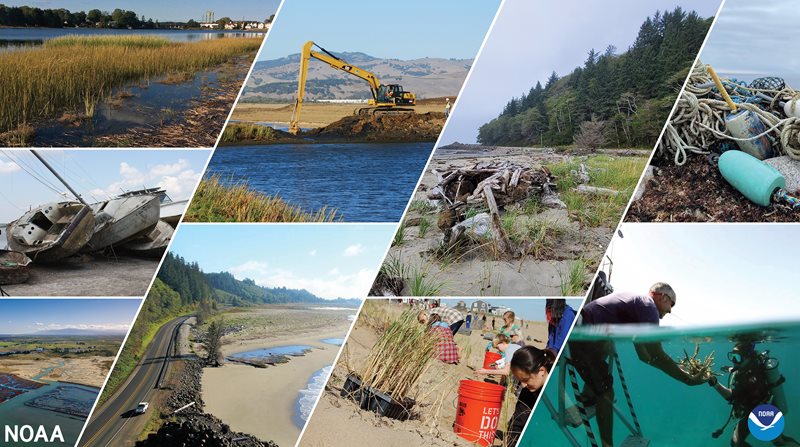
A photo collage of some of the projects being recommended for funding under the Bipartisan Infrastructure Law and NOAA's Climate-Ready Coasts initiative. (Image credit: NOAA)
Natural barriers like marshland, dunes, and floodplains provide critical protection from storms and rising sea levels. New funding from the National Oceanic and Atmospheric Administration (NOAA) will invest $74.4 million across 14 projects in Washington state to enhance these protections, create jobs, and support healthy natural environments. This funding is part of a nationwide $562 million investment in climate resilience from the Climate-Ready Coasts initiative, which is funded through the Bipartisan Infrastructure Law (BIL) and Inflation Reduction Act (IRA).
Ecology will receive $2.32 million to help Padilla Bay National Estuarine Research Reserve protect 74.5 acres of former and current tidal marsh as part of a larger overall effort to restore up to 105 acres of tidal marsh, in coordination with the Skagit Land Trust.
Along with the marshland restoration efforts, the project will increase climate resilience by reducing flood risk for the only road and utility corridor that serves the Samish Island community. The project also will restore Tribal access to the site, which historically supported natural resources stewarded and utilized by a former nearby Samish Indian village.
In Willapa Bay, the Washington State Department of Transportation — in coordination with Ecology — will receive $3.98 million to restore and protect Graveyard Spit. These funds will be leveraged alongside $9.98 million in previously awarded infrastructure funding from the National Fish and Wildlife Foundation to finance the project.
The Graveyard Spit Restoration and Resilience Project will include the rehabilitation and revegetation of the historic barrier dune on the spit and the construction of a naturally sloped cobble berm. The Shoalwater Bay Indian Tribe will carry out monitoring of endangered bird species during project implementation, while Ecology will monitor dune conditions to inform final construction plans and future adaptive management.
Once complete, the project will protect and restore marsh and tidal bay environments; enhance habitat for western snowy plovers, streaked-horned larks, and salmonids; provide coastal hazard mitigation for the communities of North Cove, Tokeland, and the Shoalwater Bay Indian Tribe; and protect the region’s primary transportation corridor, State Route 105, from erosion, debris, and flooding.
The other 12 projects in Washington will advance restoration actions, support recovery of important fisheries, help address invasive species threats, and remove marine debris from coastal environments.
States and federal agencies work together on coastal protections
States and territories have partnered with the federal government through the Coastal Zone Management Act for 50 years to preserve, protect, develop, restore, and enhance the resources of the nation's coasts.
In recent decades, the challenges facing coastal communities have grown, said Dr. Jude Apple, Director of Ecology’s Padilla Bay National Estuarine Research Reserve.
“Padilla Bay and the other NERRS (National Estuarine Research Reserves) are unique in that we are local, place-based programs that leverage federal, state, and local resources to address challenges facing coastal communities and ecosystems,” Apple said. "Investments from the Bipartisan Infrastructure Law and the Inflation Reduction Act provide the support necessary to protect local ecosystems and communities by mitigating habitat loss and improving resilience to sea level rise and coastal flooding.”
This new funding announcement marks a transformational moment in Washington’s ability to proactively address rising sea levels, coastal development, and increasing environmental challenges that face the state's coasts.
Coastal resilience is not a one-size-fits-all undertaking; funding to state coastal programs, NERRS, and regional and local grant programs will empower states to prepare their coastal communities for hazards in ways that are specifically suited to their needs.

